Protein sequence(P15692-9, Ala27-Arg147, with C-10*His) APMAEGGGQNHHEVVKFMDVYQRSYCHPIETLVDIFQEYPDEIEYIFKPSCVPLMRCGGCCNDEGLECVPTEESNITMQIMRIKPHQGQHIGEMSFLQHNKCECRPKKDRARQEKCDKPRRGGGGSHHHHHHHHHH
Theoretical:15.7kDa Actual:16kDa
>90% by SDS-PAGE
12 months from date of receipt, -20 to -70 °C as supplied. 6 months, -20 to -70 °C under sterile conditions after reconstitution. 1 week, 2 to 8 °C under sterile conditions after reconstitution. Please avoid repeated freeze-thaw cycles.
Vascular endothelial growth factor (VEGF-121) is a naturally-occurring VEGF-A splice variant involved in embryonic vasculogenesis and angiogenesis. VEGF binds to VEGFR-1 and VEGFR-2, and activates Raf/MEK/ERK and PI3K/AKT pathways. VEGF-121 is released as a freely diffusible protein by a variety of normal and transformed cells. It plays an important role in neurogenesis both in vitro and in vivo. It has neurotrophic effects on neurons of the central nervous system and promotes growth and survival of dopaminergic neurons and astrocytes. VEGF also promotes growth and survival of vascular endothelial cells, monocyte chemotaxis, and colony formation by granulocyte-macrophage progenitor cells.

Immobilized Human VEGF 121, His Tag at 4 μg/mL (50 μL/well) can bind VEGF-R2/KDR Fc Chimera Protein, Human (Cat. No. UA010144) with EC50 of 17.8-21.8 ng/mL.

2μg(R: reducing conditions)